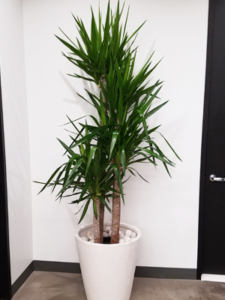
Plants make the essential nutrients they need through photosynthesis
Plants are amazing. Did you know that they manufacture their own food? Unlike any other organism, plants are able to make their own nutrients through photosynthesis. They create their own food through their leaves. Leaves are the food factories of a plant. The raw materials they use are simple. Carbon dioxide, water and a few minerals, combined with the power of the sun are all they need to survive, grow and reproduce.
The amazing process
Carbon dioxide (CO2) is a gas surrounding the leaves in the air. Plant leaves absorb CO2 through specialized pores called stomata. Water, and the minerals dissolved within it, is collected by the roots from the ground and moved upwards to the leaves. Here in the leaves specialized agents, called chlorophyll, mix and process these raw materials within the tissues. Powered by the energy of the sun, chlorophyll is able to combine these elements and produce food in the form of starches and sugars. These are the foods from which plants build their various tissues. This whole process is called photosynthesis, and is unique to the plant world. They create their own food and off-gas oxygen as a by-product. We turn around and eat them and breathe the oxygen they create. Daylight is essential for this process to occur. Each and every plant has evolved unique leaf patterns to collect light so that they can seek out the available sunlight and photosynthesize for their very survival. CO2 mixed with water, and driven by the power of light, makes food for the plant.
A leafy look
First and foremost, plant leaves are solar collector panels, capturing light energy to produce carbohydrates for growth. This is why the leaves of most shade plants are large; to capture as much of the light that has filtered down to them at the bottom of the plant canopy. Leaves of shade plants are also thinner so the energy expended on them is invested mostly in the size of the “solar panel.” For the same reason, leaves of sun plants will typically be smaller yet still collect plenty of light and their “solar panels” do not need to be as big.
Take a look around at the plants in your accounts and you’ll notice that most plants used in interiorscapes are the large-leafed shade plants. You’ll also see that the larger-leafed plants (Spathiphyllum, Aglaonema, Philodendron) are in the darker locations and the smaller-leafed plants (Ficus, Leea, Aeschynanthus) are closer to windows.
The photosynthesis process of harnessing light is the first step in the unique procedure of plants in which they manufacture their own food in their leaves. Potential energy reaches the earth in the form of sunshine yet members of the animal kingdom have never been able to make use of this energy as well as plants have. Plants have perfected the use of harnessing solar energy. They efficiently trap each ray of light when it strikes the green screen of vegetation.
The rate and amount of plant growth is directly related to the amount of light a plant receives (sunlight or artificially supplemented). Light is energy, it runs the machine and the food making process. Many plants in low-light interiorscapes do not exhibit much growth.
All plants have a predetermined light requirement. This is why, even with adaptations, some are more suited to the shade and others do better in the sun. It’s in their genes!
Heliogetarian?
Plants are sun worshippers. Their dietary style isn’t vegetarian or lactose intolerant. We need to understand this difference and not try to “feed” them a special “food” when they aren’t doing well. A common question from the plant novice is, “My plant is sick…Does it need food?” What they are asking is, “Does it need fertilizer?” They are trying to treat the plant like it is an animal. They are thinking it must be hungry, that they are starving their plant and by giving it “food” it will respond like animals do and be healthy. Fertilizer is not food it’s a mineral supplement that enhances the soil.
Indeed, interiorscape plants can “starve to death.” But they starve in a very “plant” way. The most common way they starve to death is from a lack of light. They must have light to survive. They are heliogetarians.
Now you know why plants need to be be “fed” sunshine!
